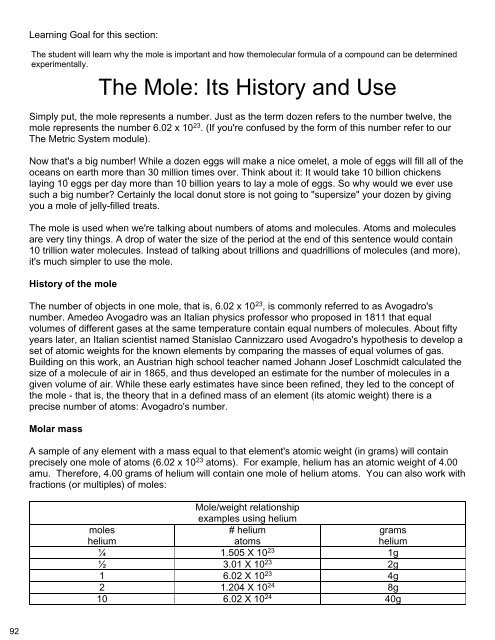You also want an ePaper? Increase the reach of your titles
YUMPU automatically turns print PDFs into web optimized ePapers that Google loves.
Isomers<br />
Because carbon can bond in so many different ways, a single molecule can have different bonding<br />
configurations. Consider the two molecules illustrated here:<br />
C6H14<br />
CH3CH2CH2CH2CH2CH3<br />
C6H14<br />
CH3<br />
I<br />
CH2CH2CH2CH2CH3<br />
Both molecules have identical chemical formulas (shown in the left column); however, their structural<br />
formulas (and thus some chemical properties) are different. These two molecules are called isomers.<br />
Isomers are molecules that have the same chemical formula but different structural formulas.<br />
Functional groups<br />
In addition to carbon and hydrogen, hydrocarbons can also contain other elements. In fact, many<br />
common groups of atoms can occur within organic molecules, these groups of atoms are called<br />
functional groups. One good example is the hydroxyl functional group. The hydroxyl group consists of<br />
a single oxygen atom bound to a single hydrogen atom (OH - ). The group of hydrocarbons that contain<br />
a hydroxyl functional group is called alcohols. The alcohols are named in a similar fashion to the<br />
simple hydrocarbons, a prefix is attached to a root ending (in this case "anol") that designates the<br />
alcohol. The existence of the functional group completely changes the chemical properties of the<br />
molecule. Ethane, the two-carbon alkane, is a gas at room temperature; ethanol, the two-carbon<br />
alcohol, is a liquid.<br />
Ethanol<br />
Ethanol, common drinking alcohol, is the active ingredient in "alcoholic" beverages such as beer and<br />
wine.<br />
Summary<br />
The chemical basis of all living organisms is linked to the way that carbon bonds with other atoms.<br />
This introduction to organic chemistry explains the many ways that carbon and hydrogen form bonds.<br />
Basic hydrocarbon nomenclature is described, including alkanes, alkenes, alkynes, and isomers.<br />
Functional groups of atoms within organic molecules are discussed.<br />
89



